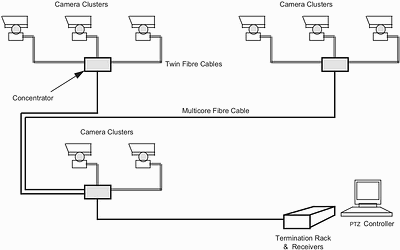
Continuing from the previous article in which we took a look at the selection criteria of transmission components, which is the first activity of the design process. We now discuss the second activity of the design process – design of the passive fibre-optic cable infrastructure.
Cable Infrastructure
Once the transmission requirements have been defined, it is possible to commence the design of the fibre-optic cabling infrastructure, which includes not only the fibre-optic cables themselves, but also all ancillary components such as joint boxes, fibre patch panels and jumper cables.
The first task is to confirm the number and type of fibres involved, which will have been defined during the selection of the transmission components. Unless the proposed system is long haul (ie, greater than about 10 km), or involves the transmission of multiplexed video signals, or the client is an existing user of singlemode fibres for other applications (eg, a cable TV operator), then it is likely that the optimum choice will be either 50/125 µm or 62,5/125 µm graded index multimode fibre. Traditionally the UK choice has been to use 50/125 µm fibre for CCTV applications and 62,5/125 µm for computer LANs. However, either fibre may be used for either application, and in fact most other countries use 62,5/125 µm fibre for both.
The number of fibres required will be defined by the quantity and relative location of cameras, together with the choice of single or dual fibre telemetry transmission and/or multiplexing as discussed earlier. Since the incremental cost of providing additional fibres within a given cable is fairly small, especially compared to the cost of civil works involved, due consideration should be given to installing a reasonable amount of excess fibre capacity. Beware, however, of specifying too many fibres in the same cable. Not only will this make the system unnecessarily vulnerable to a damaged cable, but these will be difficult to obtain 'off the shelf', and may be subject to minimum order quantities and extended lead times.
Fibre-optic cables intended for laying in external ducts or for direct burial in trenches are usually loose tube designs typically containing between two and 24 fibres within one or more tubes. Cables intended for duct installations are provided with moisture protection, either by means of an aluminium tape moisture barrier (dry loose tube) or by a water-blocking agent (gel-filled cable). For direct burial applications, the cable may be fitted with steel wire armour. Ideally all cables should be manufactured from low smoke flame-retardent (LSF) materials in order to comply with local authority fire regulations.
Many short-range CCTV systems will be configured in a star configuration, with unbroken runs of cable from each camera to the control room. For these systems, the optimum cable design will contain two fibres, for video and telemetry respectively. This arrangement effectively provides 100% excess fibre capacity, as where necessary the video and telemetry may be combined on to just one of the fibres. Larger networks may benefit from the use of an inverted 'branch and tree' topology (Figure.1). In these networks, twin fibres are installed from each camera to a local 'concentrator', at which point they are spliced to a single multifibre cable. The concentrator itself is little more than a simple weatherproof joint box, which may often be combined with one of the camera equipment boxes.

At the control room, the incoming fibre-optic cables will usually terminate in a 19-inch rack-mounted patch panel, with each fibre presented individually in a standard ST optical connector. Short single ruggedised jumper cables, fitted with mating ST connectors at each end, are used to complete the optical link to the fibre-optic receiver. No special skills are required to complete the patching arrangements, apart from a reasonable understanding of the need for care in fibre handling (eg, not bending a fibre optic-cable to a tighter radius than 10x its overall cable diameter) and general hygiene (ie, cleanliness) requirements.
We conclude the design process in the closing article of this series, which you can look forward to in the October edition of Hi-tech Security Solutions. We take a closer look at optical loss budget, discuss system tests and commissioning and we perform a cost comparison between fibre and copper.
For more information contact Elvey Security Technologies, 011 401 6700, [email protected], www.elvey.co.za
| Tel: | +27 11 401 6700 |
| Email: | [email protected] |
| www: | www.elvey.co.za |
| Articles: | More information and articles about Elvey Security Technologies |

© Technews Publishing (Pty) Ltd. | All Rights Reserved.